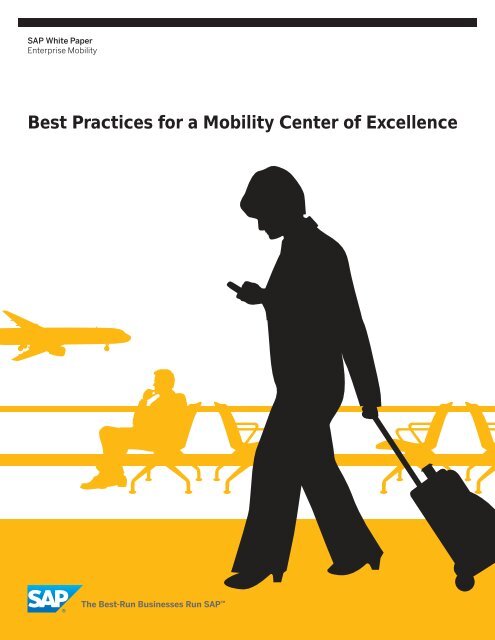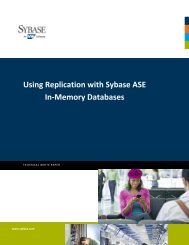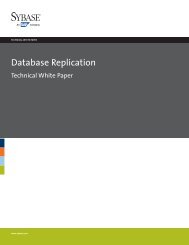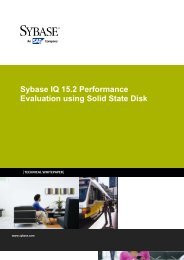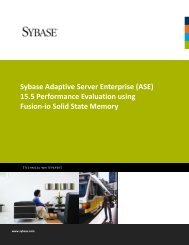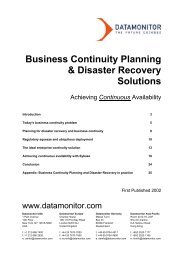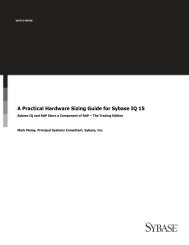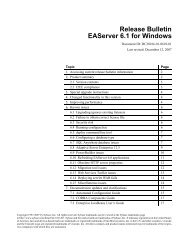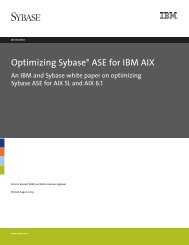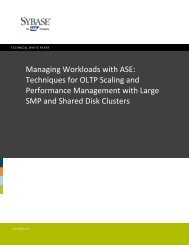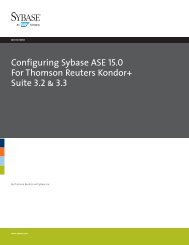Best Practices for a Mobility Center of Excellence - Sybase
Best Practices for a Mobility Center of Excellence - Sybase
Best Practices for a Mobility Center of Excellence - Sybase
You also want an ePaper? Increase the reach of your titles
YUMPU automatically turns print PDFs into web optimized ePapers that Google loves.
SAP White Paper<br />
Enterprise <strong>Mobility</strong><br />
<strong>Best</strong> <strong>Practices</strong> <strong>for</strong> a <strong>Mobility</strong> <strong>Center</strong> <strong>of</strong> <strong>Excellence</strong>
Table <strong>of</strong> Contents<br />
5 <strong>Best</strong> <strong>Practices</strong> <strong>for</strong> a <strong>Mobility</strong> <strong>Center</strong><br />
<strong>of</strong> <strong>Excellence</strong><br />
Exploring a <strong>Mobility</strong> <strong>Center</strong> <strong>of</strong><br />
<strong>Excellence</strong><br />
6 Dimensions <strong>of</strong> the <strong>Mobility</strong> CoE<br />
Scope<br />
Organization<br />
Governance<br />
9 Six <strong>Best</strong> <strong>Practices</strong> <strong>for</strong> Success
As mobility adoption across the enterprise continues at a rapid<br />
pace, IT organizations are trying to deal with the following unique<br />
mobility challenges.<br />
• There is an unprecedented rate <strong>of</strong> change across the ecosystem.<br />
• <strong>Mobility</strong> has the potential to be applicable across the entire<br />
organization.<br />
• End-user expectations <strong>of</strong> delivery lifecycles are signifi cantly<br />
diff erent.<br />
• There are implications <strong>for</strong> security.
<strong>Best</strong> <strong>Practices</strong> <strong>for</strong> a <strong>Mobility</strong> <strong>Center</strong> <strong>of</strong><br />
<strong>Excellence</strong><br />
First, mobile technology is constantly<br />
changing. In fact, the pace <strong>of</strong> change in<br />
innovation and technology in mobility is<br />
faster than other IT areas. This rapid<br />
pace <strong>of</strong> change – in terms <strong>of</strong> requirements<br />
and technology – results in the<br />
need <strong>for</strong> greater alignment between lines<br />
<strong>of</strong> business and IT on mobility initiatives,<br />
to prevent duplication <strong>of</strong> eff ort. The enterprise<br />
also has to deal with a proliferation<br />
<strong>of</strong> devices, vendors, and services:<br />
iPhone, iPad, Google Android, BlackBerry,<br />
Windows Phone, and more.<br />
Secondly, mobile devices are everywhere<br />
and being used by everyone. This<br />
pervasiveness creates opportunities to<br />
make employees more productive, engage<br />
with customers in a more targeted<br />
and deep way, and collaborate with partners<br />
in a streamlined fashion. This<br />
means that enterprise IT needs to plan<br />
<strong>for</strong> and be ready to meet a diverse set <strong>of</strong><br />
requirements (end users, engagement<br />
modalities, use cases, security, scalability,<br />
and so <strong>for</strong>th) while retaining suffi cient<br />
agility to meet these needs in a timely<br />
manner.<br />
Thirdly, as consumers themselves,<br />
employees are used to the relatively<br />
smooth and easy process <strong>of</strong> downloading<br />
and using mobile applications from<br />
the various app stores. This experience<br />
has conditioned them to expect a relatively<br />
rapid application development<br />
(and enhancement) timeline, without<br />
compromising on the quality and user<br />
experience <strong>of</strong> the application. The implication<br />
<strong>for</strong> enterprise application developers<br />
is clear – how do you accommodate<br />
these expectations with the existing enterprise<br />
s<strong>of</strong>tware development lifecycle<br />
(SDLC) infrastructure?<br />
SAP White Paper– <strong>Best</strong> <strong>Practices</strong> <strong>for</strong> a <strong>Mobility</strong> <strong>Center</strong> <strong>of</strong> <strong>Excellence</strong><br />
And fi nally, enterprise IT needs to put<br />
in place the appropriate infrastructure,<br />
processes, and organization to ensure it<br />
can get the desired visibility and control<br />
across the lifecycle <strong>of</strong> these mobile assets<br />
(devices, users, and applications).<br />
While some companies still issue corporate-owned<br />
devices, over 60% <strong>of</strong> companies<br />
allow employees to use personally<br />
owned devices to access corporate in<strong>for</strong>mation.<br />
This blurring <strong>of</strong> lines between<br />
pr<strong>of</strong>essional and personal devices leads<br />
to diversity and complexity, as well as<br />
data security considerations. Whether it<br />
is in the <strong>for</strong>m <strong>of</strong> self-service provisioning<br />
<strong>of</strong> mobile devices <strong>for</strong> users, deep insights<br />
into device and application usage metrics,<br />
or compliance monitoring, enterprise<br />
IT needs a robust set <strong>of</strong> tools that<br />
automate as much as possible the operational<br />
complexities <strong>of</strong> a mobile infrastructure<br />
and still provide actionable insights<br />
to deal with issues and exceptions<br />
as needed.<br />
EXPLORING A MOBILITY CENTER OF<br />
EXCELLENCE<br />
A mobility center <strong>of</strong> excellence (MCoE)<br />
is an attempt to coalesce around a set <strong>of</strong><br />
principles – organizational and architectural<br />
– <strong>for</strong> an eff ective and effi cient use<br />
<strong>of</strong> mobility across the entire enterprise.<br />
By capturing learnings, best practices,<br />
and reference architectures from mobility<br />
projects within the organization, the<br />
mobility CoE not only accelerates mobility<br />
deployment within the corporation, it<br />
also minimizes overall eff ort, as each<br />
workgroup or business unit no longer<br />
has to reinvent and implement mobility<br />
policies on its own.<br />
A mobility CoE provides the leadership<br />
needed to deploy and manage personal<br />
and corporate-owned mobiles devices<br />
seeking access to corporate data. The<br />
group uses a combination <strong>of</strong> standards<br />
and policies, along with technology infrastructure<br />
and skills, to alleviate the challenges<br />
<strong>of</strong> enterprise mobility.<br />
The mobility center <strong>of</strong> excellence facilitates<br />
success by:<br />
• Leveraging existing IT processes (standards,<br />
governance) and people<br />
• Defi ning standards, vendor and technology<br />
selection, and security policies<br />
relevant to mobility<br />
• Acting as the trusted advisor to the<br />
line <strong>of</strong> business leaders<br />
• Reviewing, evaluating, and approving<br />
mobility projects<br />
• During implementation, providing<br />
technology expertise to the business,<br />
authoring best practices, and facilitating<br />
training and technical support<br />
• Post-deployment, <strong>of</strong>f ering thought<br />
leadership, consulting on mobile technology,<br />
and providing metrics reporting<br />
and support<br />
5
Dimensions <strong>of</strong> the <strong>Mobility</strong> CoE<br />
Diff erent organizations are in diff erent<br />
stages <strong>of</strong> their mobility adoption and maturity,<br />
which in turn shapes their experience<br />
level, competency mix, and com<strong>for</strong>t<br />
level with mobility. Regardless, a mobility<br />
CoE has three broad but interlinked dimensions<br />
as shown in the Figure 1 below.<br />
SCOPE<br />
As a fi rst order <strong>of</strong> business, you need<br />
to defi ne the scope and the charter <strong>of</strong><br />
the mobility CoE. This is an essential element<br />
to grounding the MCoE <strong>for</strong> everything<br />
it does going <strong>for</strong>ward. We recommend<br />
that you answer the following<br />
questions to help defi ne the scope <strong>of</strong><br />
your MCoE.<br />
• What is the core function <strong>of</strong> the MCoE?<br />
Are you setting it up to act in a purely<br />
community enablement function –<br />
that is, to drive better collaboration on<br />
mobility initiatives across the organization<br />
by providing the infrastructure<br />
(knowledge management, social me-<br />
Figure 1: Dimensions <strong>of</strong> the <strong>Mobility</strong> CoE<br />
Scope<br />
Organization Governance<br />
dia, and so on) and organizational tools<br />
(such as communities <strong>of</strong> practice)? Or<br />
is the function to shape and drive a<br />
mobility strategy <strong>for</strong> the organization<br />
that can be used by the various departments<br />
and business units to use <strong>for</strong><br />
their mobility initiatives? Or is the intent<br />
to use the MCoE to guide the<br />
strategy and also provide support on<br />
mobility projects – whether in the <strong>for</strong>m<br />
<strong>of</strong> creating usability guidelines, defi ning<br />
architecture principles, recommending<br />
specifi c technology choices,<br />
or managing an initial set <strong>of</strong> pilots or<br />
pro<strong>of</strong>s <strong>of</strong> concepts (POCs)?<br />
• How broad is the span <strong>of</strong> mobility capabilities<br />
that the MCoE covers? Since<br />
mobile technologies encompass everything<br />
from B2E to B2C applications,<br />
enterprise mobile management (<strong>of</strong><br />
which mobile device management is a<br />
component), remote access, machine<br />
to machine (M2M), RFID, and so on,<br />
you need to bound the set <strong>of</strong> mobility<br />
capabilities the MCoE will take on. It is<br />
perfectly acceptable (and even recommended)<br />
to have an aspirational statement,<br />
but start with one or two<br />
capabilities.<br />
• How will the MCoE interface with your<br />
existing IT organization? Since most IT<br />
organizations already have an existing<br />
infrastructure (processes, tools, and<br />
people), you need to defi ne what the<br />
MCoE will defi ne and create as “net<br />
new” <strong>for</strong> the sake <strong>of</strong> mobility. This will<br />
ensure minimal duplication <strong>of</strong> eff orts<br />
and leave “regular IT” relatively unchanged,<br />
thus causing as little disruption<br />
to ongoing IT activities as possible.<br />
ORGANIZATION<br />
Once the scope <strong>for</strong> the MCoE has<br />
been defi ned, the next element to review<br />
is the underlying organizational structure<br />
and associated ways <strong>of</strong> working.<br />
This starts with securing buy-in from<br />
major stakeholders across the organization.<br />
Since mobility has an impact across<br />
most <strong>of</strong> the organization, it is important<br />
to get sponsorship from senior and infl uential<br />
individuals across business and IT<br />
<strong>for</strong> the MCoE. Securing this kind <strong>of</strong> executive<br />
sponsorship conveys the importance<br />
<strong>of</strong> mobility (and the MCoE) and<br />
lends legitimacy to the entire eff ort.<br />
With sponsorship identifi ed and secured,<br />
the next steps are outline the key<br />
roles and reporting structure within the<br />
MCoE, specifying the competencies required<br />
to staff these roles, and building<br />
out the organization.
A critical decision at this point is to<br />
pick the person to lead the MCoE. Since<br />
this person serves as the focal point <strong>for</strong><br />
mobility within the organization, this person<br />
needs to be, among other things:<br />
• Com<strong>for</strong>table defi ning “art <strong>of</strong> the possible”<br />
mobility scenarios<br />
• Credible across business and IT<br />
leadership<br />
• Pr<strong>of</strong>i cient in driving and delivering on<br />
innovation<br />
• Grounded in real-world IT project<br />
delivery<br />
In addition to the leader, here are<br />
some roles to consider staffi ng the MCoE<br />
organization with:<br />
• Solution architect<br />
• Usability specialist<br />
• Business analyst<br />
Given that most MCoEs are bootstrapped<br />
– that is, not created and fully<br />
staff ed from the very beginning – deciding<br />
on which resources will be full time<br />
versus part time is important. We recommend<br />
that you start with a full-time<br />
MCoE leader and explore leveraging resources<br />
from other parts <strong>of</strong> the organization<br />
(application development, technology<br />
architecture, UX, and so on).<br />
With the organization structure and<br />
the roles identifi ed, you need to defi ne<br />
the responsibilities <strong>of</strong> the individuals in<br />
terms <strong>of</strong> key work activities and<br />
deliverables.<br />
As you get started on bootstrapping<br />
the MCoE, you should look to your supplier<br />
ecosystem (carrier/telco, system integrator,<br />
network, security vendors, and<br />
so <strong>for</strong>th) <strong>for</strong> resources that can support<br />
the MCoE.<br />
GOVERNANCE<br />
SAP White Paper– <strong>Best</strong> <strong>Practices</strong> <strong>for</strong> a <strong>Mobility</strong> <strong>Center</strong> <strong>of</strong> <strong>Excellence</strong><br />
This element <strong>of</strong> the MCoE defi nes:<br />
• The ground rules <strong>for</strong> its operations<br />
• The funding model<br />
• The mechanism by which decisions<br />
are made<br />
• The criteria used to track its ongoing<br />
eff ectiveness<br />
• The process <strong>for</strong> communicating key<br />
decisions and milestones to its<br />
stakeholders<br />
In defi ning the governance <strong>for</strong> the<br />
MCoE, it is important to keep this process<br />
lightweight and pragmatic. For a<br />
space that is moving as fast as mobility,<br />
you need a governance process that is<br />
nimble yet robust enough to get the desired<br />
results. Being transparent about<br />
how mobility projects are reviewed, approved,<br />
and delivered is a critical part <strong>of</strong><br />
the governance model.<br />
We fi nd that three <strong>of</strong> the most commonly<br />
addressed areas within governance<br />
relate to architecture, security,<br />
and operations.<br />
Within architecture, typical questions<br />
that need to be addressed are:<br />
• How will you decide which modality (or<br />
more than one) to use <strong>for</strong> a specifi c<br />
application – native client, HMTL5 app,<br />
hybrid app, mobile browser, text messaging/SMS?<br />
Drive a culture <strong>of</strong> agility, fl exibility,<br />
and customer centricity among the<br />
CoE team.<br />
• How will mobile application development<br />
be integrated with your existing<br />
s<strong>of</strong>tware development lifecycle (SDLC)<br />
tools and process – <strong>for</strong> example,<br />
change management, version control,<br />
patterns, code reuse, defect tracking,<br />
and the like?<br />
• What will your mobile user experience<br />
guidelines be? What parts <strong>of</strong> your existing<br />
user experience principles can<br />
you carry over to mobile?<br />
• How will mobile align with other enterprise<br />
initiatives such as enterprise 2.0,<br />
service-oriented architecture (SOA),<br />
collaboration, and so on?<br />
When it comes to security, some <strong>of</strong> the<br />
items that require addressing are:<br />
• Do you support “bring your own device”<br />
(BYOD)?<br />
• If yes,<br />
– What is the process <strong>for</strong> specifying<br />
the list <strong>of</strong> supported devices under<br />
the BYOD policy? Does it cover<br />
smart phones and tablets?<br />
– What processes and infrastructure<br />
do you need to get the desired level<br />
<strong>of</strong> security and visibility across the<br />
lifecycle <strong>of</strong> the mobile assets?<br />
– How do you account <strong>for</strong> country-<br />
and region-specifi c data privacy regulations<br />
and their impact on BYOD?<br />
7
– What is the policy <strong>for</strong> reimbursing<br />
employees on telecom charges?<br />
• If not,<br />
– Do you support any individual liable<br />
(IL) devices at all? If yes, what are<br />
the constraints?<br />
– How do you communicate the trade<strong>of</strong>f<br />
s and implications to your<br />
employees<br />
• What changes do you need to make to<br />
your existing in<strong>for</strong>mation security<br />
policy?<br />
• How do you amend the standard acceptable<br />
use policy to account <strong>for</strong> mobile<br />
devices?<br />
• What guidelines do you develop <strong>for</strong><br />
mobile applications in terms <strong>of</strong> mandatory<br />
and optional requirements <strong>for</strong><br />
security – authorization, authentication,<br />
and auditing (AAA), data at rest,<br />
data in motion, and so on?<br />
For IT operations, mobility brings up<br />
the following key items that need to be<br />
addressed (some <strong>of</strong> these are related to<br />
the security issues above):<br />
• How will your mobile assets (devices<br />
and applications) be managed across<br />
their lifecycle (from provisioning all the<br />
way through refresh)?<br />
• Which parts <strong>of</strong> these will you automate?<br />
How much <strong>of</strong> this should be<br />
made self-service so as to reduce the<br />
burden on IT? And what do you need to<br />
put in place to make this happen?<br />
• What does “support” mean? What service-level<br />
agreement (SLA) can you<br />
provide <strong>for</strong> these devices and<br />
applications?<br />
• If users get an unsupported device,<br />
what is your support policy?<br />
• What skill sets do you need to support<br />
mobility, and how will you staff up <strong>for</strong><br />
that?<br />
For a space that is moving as fast as mobility, you need a<br />
governance process that is nimble yet robust enough to<br />
get the desired results.
Six <strong>Best</strong> <strong>Practices</strong> <strong>for</strong> Success<br />
For the <strong>Mobility</strong> CoE to succeed, follow<br />
this core set <strong>of</strong> best practices.<br />
1. Secure executive sponsorship –<br />
Without strong executive sponsorship, a<br />
mobility CoE cannot function eff ectively.<br />
It will not be able to get the visibility and<br />
the organizational muscle it needs to<br />
drive a consistent approach to mobility<br />
across the business. As a technology,<br />
mobility has the potential to impact every<br />
part <strong>of</strong> your business, and you want<br />
the backing <strong>of</strong> someone who can help<br />
you keep the distinct mobility approaches<br />
within your organization to a manageable<br />
minimum.<br />
2. Drive a partnership between business<br />
and IT – Closely tied to sponsorship<br />
is the need to get strong partnership between<br />
business and IT. While this may<br />
sound clichéd and trite to experienced IT<br />
pr<strong>of</strong>essionals, it is all the more true with<br />
mobility – as pervasive as mobility is, we<br />
are all consumers <strong>of</strong> it. And we expect<br />
the enterprise to provide reasonably similar,<br />
if not identical, mobile capabilities as<br />
we experience in our daily lives. A successful<br />
mobility CoE will demonstrate<br />
how to embrace mobility to trans<strong>for</strong>m<br />
the business. Benefi ts <strong>of</strong> mobility may include<br />
a reduction in administrative processing<br />
on simple processes such as vacation<br />
requests and timesheets. The<br />
mobility CoE may be able to better predict<br />
or determine the areas <strong>of</strong> the business<br />
where process changes could result<br />
in time or revenue savings to departmental<br />
budgets. Part <strong>of</strong> the responsibility <strong>of</strong><br />
SAP White Paper– <strong>Best</strong> <strong>Practices</strong> <strong>for</strong> a <strong>Mobility</strong> <strong>Center</strong> <strong>of</strong> <strong>Excellence</strong><br />
the mobility CoE could be to align the<br />
company’s mobility solutions with the<br />
product lifecycle. For example, consider<br />
how the company will be using mobile<br />
devices in the sell and service stages <strong>of</strong><br />
the lifecycle versus the design and develop<br />
stages. Consider sales channels and<br />
product lifecycle stages to determine<br />
which mobile applications to develop.<br />
3. Drive eff ective engagement with<br />
end users – Understanding your end users’<br />
mobility needs at a relatively granular<br />
level requires you to “walk in their<br />
shoes.” Whether it is in the <strong>for</strong>m <strong>of</strong> a ridealong<br />
to document how an insurance adjuster<br />
goes about his job, or mapping out<br />
a current business process and a new<br />
mobile process <strong>for</strong> a fi eld inspector, you<br />
need to understand the various user personas<br />
involved and capture how and<br />
where mobility can be embedded in the<br />
most seamless way possible. <strong>Mobility</strong> requires<br />
a kind <strong>of</strong> engagement with end users<br />
that is diff erent from a lot <strong>of</strong> other IT<br />
capabilities.<br />
4. Defi ne a strawman mobility strategy<br />
– Once the mobility CoE is launched, the<br />
enterprise should focus on maintaining<br />
and developing the mobility strategy and<br />
framework. The mobility CoE should develop<br />
a strawman mobility strategy road<br />
map, with quarterly reviews by a steering<br />
committee. This road map could include:<br />
• Translating corporate and business<br />
strategy into mobility strategy<br />
• Creating a set <strong>of</strong> mobility capabilities<br />
according to mobile user pr<strong>of</strong>i les or<br />
personas<br />
• Creating a mobile applications strategy<br />
and framework <strong>for</strong> application<br />
adoption<br />
The strategy should include taking<br />
stock <strong>of</strong> and documenting all mobility initiatives<br />
in the company, as well as overlaying<br />
the corporation’s mobility strategy<br />
with its project portfolio. The mobility<br />
CoE should also assign budget <strong>for</strong> mobility<br />
initiatives according to priorities, and<br />
set aside budget and resources to test<br />
new or yet unproven mobility concepts.<br />
The key here is to develop a strawman<br />
strategy and evolve it based on experience<br />
gathered from ongoing mobility<br />
projects.<br />
5. Bootstrap from supplier ecosystem –<br />
In the early stages <strong>of</strong> an MCoE’s evolution,<br />
tapping into the extended resource<br />
pool across your supplier ecosystem is a<br />
useful way to supplement your internal<br />
resources. Getting capable resources<br />
from your partners to participate on a<br />
part-time basis in the initial phases <strong>of</strong><br />
your MCoE can help you glean insights<br />
into evolving device and wireless networks<br />
(from your carrier), understand<br />
considerations <strong>for</strong> industrializing your<br />
mobile application lifecycle (from your<br />
enterprise ISV and system integrator<br />
partners), and capture network/security<br />
implications (from your network equipment<br />
and security vendors).<br />
6. Start small, refi ne, and mature – As you<br />
staff up the fi rst iteration <strong>of</strong> your mobility<br />
CoE, defi ne your strawman mobility<br />
strategy, and deliver on the fi rst handful<br />
<strong>of</strong> mobility projects, you will acquire experience<br />
in the mobility lifecycle. Making<br />
sure you provide <strong>for</strong> regular updates to<br />
your mobility CoE and strategy to refl ect<br />
these learnings and technology advancements<br />
is critical to the ongoing viability<br />
and success <strong>of</strong> your mobility initiatives.<br />
However, it all starts with <strong>for</strong>ming an<br />
9
MCoE in the fi rst place – <strong>for</strong> almost every<br />
organization, it is conceivable that its<br />
mobility portfolio will include, conservatively,<br />
close to a dozen applications over<br />
the next 12–18 months. An MCoE is a<br />
critical foundation <strong>for</strong> the enterprise to<br />
eff ectively deliver on that portfolio and<br />
sustain it in a cost-eff ective manner.<br />
As mobility adoption across the enterprise<br />
continues at a rapid pace, IT organizations<br />
are trying to deal with a set <strong>of</strong><br />
unique mobility challenges. By embrac-<br />
ing a mobility center <strong>of</strong> excellence, you<br />
can not only accelerate mobility deployment<br />
within your organization but also<br />
minimize redundant eff ort to maximize<br />
success. As a leading vendor in the enterprise<br />
mobility space, SAP can partner<br />
with you to mobilize your business, providing<br />
knowledge and expertise along the<br />
way to help ensure a clear path to<br />
success.<br />
LEARN MORE<br />
For more in<strong>for</strong>mation about a <strong>Mobility</strong> <strong>Center</strong><br />
<strong>of</strong> <strong>Excellence</strong>, contact your SAP<br />
representative or visit us at:<br />
http://www.sap.com/solutions/technology/<br />
mobility-plat<strong>for</strong>m.epx
www.sap.com/contactsap<br />
(11/11) Printed in USA. ©2011 SAP AG. All rights reserved.<br />
SAP, R/3, SAP NetWeaver, Duet, PartnerEdge, ByDesign,<br />
SAP BusinessObjects Explorer, StreamWork, SAP HANA, and other<br />
SAP products and services mentioned herein as well as their respective<br />
logos are trademarks or registered trademarks <strong>of</strong> SAP AG in Germany<br />
and other countries.<br />
Business Objects and the Business Objects logo, BusinessObjects,<br />
Crystal Reports, Crystal Decisions, Web Intelligence, Xcelsius, and other<br />
Business Objects products and services mentioned herein as well as their<br />
respective logos are trademarks or registered trade marks <strong>of</strong> Business<br />
Objects S<strong>of</strong>tware Ltd. Business Objects is an SAP company.<br />
<strong>Sybase</strong> and Adaptive Server, iAnywhere, <strong>Sybase</strong> 365, SQL Anywhere, and<br />
other <strong>Sybase</strong> products and services mentioned herein as well as their<br />
respective logos are trademarks or registered trademarks <strong>of</strong> <strong>Sybase</strong>, Inc.<br />
<strong>Sybase</strong> is an SAP company.<br />
All other product and service names mentioned are the trademarks <strong>of</strong><br />
their respective companies. Data contained in this document serves<br />
in<strong>for</strong>mational purposes only. National product specifi cations may vary.<br />
These materials are subject to change without notice. These materials<br />
are provided by SAP AG and its affi liated companies (“SAP Group”)<br />
<strong>for</strong> in<strong>for</strong>mational purposes only, without representation or warranty <strong>of</strong><br />
any kind, and SAP Group shall not be liable <strong>for</strong> errors or omissions with<br />
respect to the materials. The only warranties <strong>for</strong> SAP Group products and<br />
services are those that are set <strong>for</strong>th in the express warranty statements<br />
accompanying such products and services, if any. Nothing herein should<br />
be construed as constituting an additional warranty.


